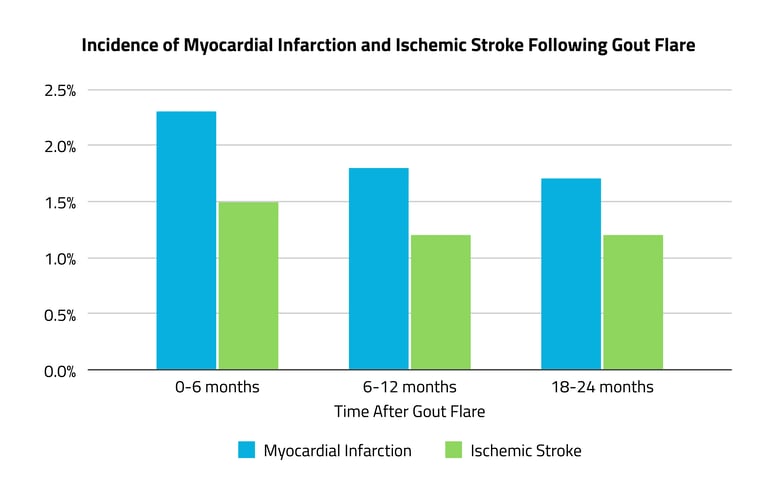Identifying High-Impact Windows for Prevention: Gout Flares Increase the Risk of Cardiac Events

Our new Prism Patient Journey analysis finds that patients are at a higher risk for cardiac events in the months following their gout flare.
In the fifth century BCE, Hippocrates described an “arthritis of the rich'' — an “unwalkable disease” that was more likely to afflict those who ate rich foods and drank more alcohol. Today, we know this disease as gout, a form of inflammatory arthritis. Evidence of the existence of gout precedes Hippocrates, having been found in mummified Egyptian remains and its qualities described in millennia of literature, from Greek legends to British history books. Gout’s connection to diet has been well established since those early observations, along with the role of other risk factors like genetics and lead exposure (the latter of which is now thought to have played a role in the disease’s historical prevalence).
Today, it’s estimated that gout affects roughly 9 million Americans — nearly 4% of the adult population. It’s characterized by low-grade inflammation and higher levels of uric acid in the blood, which accumulates and crystallizes in the joints, causing painful flare-ups. Compared to the general population, gout sufferers have higher rates of cardiovascular disease (CVD), including stroke and heart attack. Recent research from Spain found that more than half of gout patients were at “very high risk” for heart disease due to factors such as a buildup of fatty plaque in the carotid arteries; a British study found that people with gout may be twice as likely as the general population to have a heart attack or stroke. A Duke University study published in the Journal of the American Heart Association found that patients with gout and coronary artery disease were 15% more likely to die from CVD or suffer a stroke or heart attack than patients with coronary artery disease but not gout.
Until last year, the timing of cardiovascular events in relation to gout flares had not been studied. In August 2022, a U.K. study found that acute cardiovascular events were more common in the weeks and months following a gout flare; an increased risk was seen in the 60 days after a gout flare and in the 120-day period, but not in the 120-to-180-day period.
To further explore the relationship between gout flares and subsequent cardiovascular events in the U.S. population, we used Komodo Health’s Patient Journey tool, one element of our full-stack of software solutions built atop our Healthcare Map™ of over 330 million patient lives. We used closed claims data and identified 5 million patients who had experienced a gout flare between 2015 and 2021. Flares were ascertained by proxy from a diagnosis of gout, including chronic, acute, and idiopathic gout, all of which require flares to be diagnosed. We then looked for incidents of cardiovascular events in the subsequent 6, 12, 18, and 24 months of that diagnosis. Here’s what we found:
For this patient population, the risk of myocardial infarction and ischemic stroke was highest in the six months immediately following a flare and declined over the following 1.5 years.
- 2.3% experienced a myocardial infarction within 6 months, 1.8% within 6 to 12 months, and 1.7% within 18 to 24 months.
- 1.5% experienced an ischemic stroke within 6 months, 1.2% within 6 to 12 months, and 1.2% within 18 to 24 months.

In the months immediately following a gout flare, patients were more likely to be diagnosed with heart failure, asymptomatic coronary artery blockage, and peripheral vascular disease.
- 5.6% had heart failure within 6 months, 4.7% within 6 to 12 months, and 4.5% within 18 to 24 months.
- 10.7% had asymptomatic coronary artery blockage within 6 month, 9.5% within 6 to 12 months, and 9.4% within 18 to 24 months.
- 3.6% had peripheral vascular disease within 6 months, 3.2% within 6 to 12 months, and 3.1% within 18 to 24 months.
These insights can empower providers to better identify patients at risk of subsequent preventable cardiovascular events and take preventative action. They can also support the establishment of appropriate risk-mitigating protocols proceeding gout flares. CVD is the leading cause of mortality in the U.S, accounting for 1 in 5 deaths, and the CDC estimates that heart disease costs the country roughly $229 billion annually. Considering the prevalence of gout and its contribution to risk of CVD, these findings highlight a significant opportunity for targeted, high-impact, and low-cost interventions.
Komodo’s Prism Patient Journey module provides unprecedented efficiency in patient journey analyses. In just a few hours, we were able to generate insights that elucidate potentially impactful associations, which are ripe for further exploration and research as a part of our mission of reducing the burden of disease.
Check out more of our recent analyses powered by real-world evidence: Race-Based Disparities in Asthma, Fast Facts on Lung Cancer.
To see more articles like this, follow Komodo Health on Twitter, LinkedIn, or YouTube, and visit Insights on our website.







